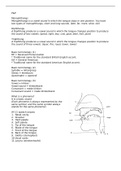P&P
Monophthongs
Monophthongs is a vowel sound In which the tongue stays in one position. You have
two types of monophthongs, short and long sounds. (bee, far, more, shoe, stir)
Diphthongs
A Diphthong produces a vowel sound in which the tongue changes position to produce
the sound of two vowels. (great, right, boy, cow, goat, beer, hair, pure)
Triphthong
A triphthong produces a vowel sound in which the tongue changes position to produce
the sound of three vowels. (layer, fire, royal, tower, lower)
Basic terminology (1)
RP = Received Pronunciation
* Traditional name for the standard British English accent.
GA = General American
* Traditional name for the standard American English accent.
Basic terminology (2)
Syllable = lettergreep
Stress = klemtoom
Apostrophe = apostrof
Basic terminology (3)
Vowel = klinker
Vowel sound = klinkerklank
Consonant = mede klinker
Consonant sound = mede klinkerklank
What is a phoneme?
It is a basic sound
(Each phoneme is always represented by the
same symbol, and the same symbol always
stands for the same phoneme)
All 11 speech organs
1. Nasal cavity
2. Alveolar
3. Hard palate
4. Soft palate
5. Tip of the tongue
6. Blade of the tongue
7. Front of the tongue
8. Back of the tongue
9. Glottis (stemspleet)
10.Vocal cords
11.Larynx (strottenhoofd)
, Voicing: voiced and voiceless sounds
Vocal cords: a pair of flexible muscles in the larynx.
When pressed tightly together, the air from the lungs cannot pass through the
windpipe tot the mouth.
When at rest, there is a gap between them
for breathing.
But they cal also flap open and shut many
times per second, and this causes vibration
which are called voice.
Sounds are either voiced or voiceless.
Vowel sounds are always voiced, vocal
cords are vibrating.
Some consonant sounds are voiced, others
are voiceless.
The Voiced consonant sounds are
pronounced with the vocal cords vibrating
too, E.g. /d/, /b/, /z/.
The voiceless consonant sounds are
pronounced without vibrations, Eg. /t/, /p/, /s/.
Voice can also be switched off altogether.
This is called whispering.
To produce correct vowel sounds you have to
use the lips. In order to learn the correct
position of the tongue and the lips, te vowel diagram is used.
This chart is an aid chart to see the movement of the tongue and the shape of the lips.
Three-term label
1. Whether the lips are rounded or not
* Rounded or unrounded
2. The degree to which the tongue is raised
* Open, half open, half close or close
3. The part of the tongue that is active:
* Front, central or black
Vowel sounds are always voiced;
vocal cords vibrating.
Some consonant sounds are voiced,
sone are voiceless
* The voiced consonant sounds
are pronounced with the vocal
cords vibrating /d/, /b/, /z/.
* The voiceless consonant sounds
are pronounced without vibration
/t/, /p/, /s/.
(1) Rounded or unrounded
The shape of the lips is very
important.





